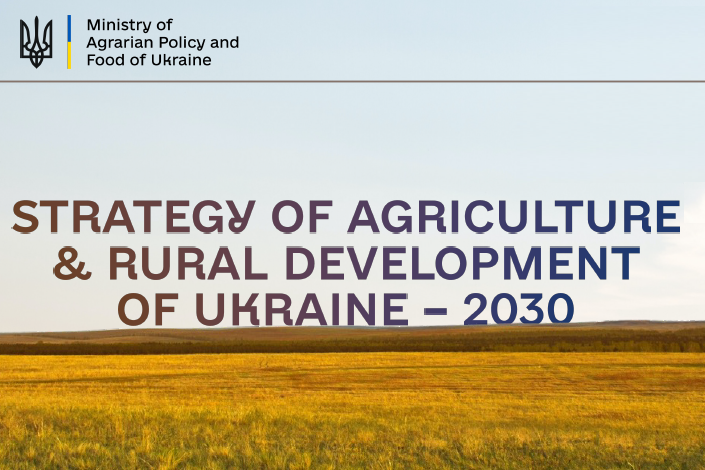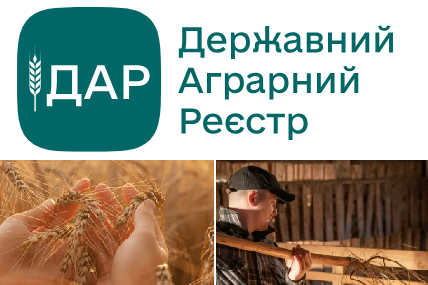Ukraine: strategy for agriculture and rural development-2030
Focus areas for Dutch-Ukrainian Cooperation

The Ministry of Agrarian Policy presented the Strategy for the Development of Agriculture and Rural Territories in Ukraine until 2030
The Ministry of Agrarian Policy and Food of Ukraine together with the EU and FAO project "Institutional and Political Reform of Small-Scale Agriculture in Ukraine" (IPRSA) presented the Strategy for the Development of Agriculture and Rural Areas in Ukraine for the period until 2030.
It provides for a clear definition of priorities and the creation of favorable conditions for the development of agriculture and rural areas of Ukraine. The strategy was developed taking into account the need for changes in the agricultural sector, in particular those related to granting Ukraine the status of a candidate for EU accession and other international obligations.
The document contains 7 strategic goals, each of which includes a vision and sub-goals. Their implementation is expected by 2030.

Goal 1. Creation of an inclusive policy for the development of agriculture and rural areas: institutional capacity.
State institutions in the agricultural sector will be reformed in accordance with the common agricultural policy of the EU.
As part of this goal, the Law on the State Agrarian Register will also be adopted. It is planned that more than 80% of state support for agriculture will come through State Agrarian Register (DAR - Державний аграрний реєстр (dar.gov.ua)). Amending legislation and creating a payment agency that will ensure timely and accurate payment of support to agricultural producers.

Goal 2. Ensuring public needs for high-quality, nutritious and safe food products: achieving food security.
It is envisaged to adopt a comprehensive EU food safety policy and control standards in the field of sanitary and phytosanitary measures (SPF), which are fully harmonized with EU requirements.

Goal 3. Ensuring the sustatinability of the agricultural sector: maintaining a stable and fair income of producers, increasing their competitiveness.
Programs will be implemented to support liquidity, state guarantees, as well as grant funding, mitigation or partial reimbursement of costs to overcome the consequences of the war. Support of stable income of farms. Strengthening market orientation and increasing competitiveness.

Goal 4. Effective use of land: demining, land reform.
In particular, further functioning of the land market, development of monitoring of the land market and creation of an automated system of public monitoring of land relations are envisaged. It is planned to create and ensure the functioning of a national geoportal, which will become a source of accurate, reliable, up-to-date and, most importantly, official data on geospatial objects. The goal also involves sustainable development and efficient use of soil, air and water, including by reducing dependence on chemicals.

Goal 5. Climate-oriented agriculture: climate change mitigation and adaptation.
The goal includes the development of water supply for land irrigation, climate-oriented agriculture, organic production, circular/sustainable bioeconomy, and bioenergy.
Also, measures will be aimed at preventing the loss of biodiversity, improving ecosystem services and preserving habitats and landscapes. Implementation of simplified seed registration, prevention of spreading of GMO seeds outside the EU seed catalogs.

Goal 6. Modernization of the agricultural sector: development of processing, innovation, digitization and exchange of knowledge.
It is envisaged to promote the development of processing enterprises, improve access to research and innovation. Support for rural business development and agricultural advisory services, digitization of the industry.

Goal 7. Creation of conditions for the development of rural areas.
Support of young farmers, development of women's entrepreneurship.
The Representatives of the Embassy took part in the meeting on the strategy on Friday 7 June.


The draft Strategy for the Development of Agriculture and Rural Territories in Ukraine until 2030 is posted for discussion on the website of the Ministry of Agrarian Policy at the link (UKR) . The Government is planning to approve the Strategy by the end of 2024.
Download the presentation of the strategy
More news on this topic
KYIV. June 7 (Interfax-Ukraine) – The agricultural sector, without exaggeration, is one of the key pillars on which the Ukrainian economy rests, generating 62% of foreign currency earnings from exports alone in 2023, stated Deputy Prime Minister for European and Euro-Atlantic Integration of Ukraine, Olha Stefanishyna.
"The Ukrainian agricultural sector has withstood difficult conditions and continues its activities, supporting the economy, ensuring food security not only in Ukraine but also worldwide, including African countries, the Middle East, and Southeast Asia," she said at the presentation of the Strategy for the Development of Agriculture and Rural Areas until 2030 in Kyiv on Friday.
She recalled that a significant part of Ukrainian agricultural products was exported to the European Union countries, with which a free trade area was and is in effect, partly thanks to the unprecedented measures from the EU, which at the start of the war introduced autonomous trade preferences and increased Ukraine's logistical capabilities through Solidarity Lanes.
The Deputy Prime Minister said that this EU decision was made possible due to the experience of implementing the association agreement, the development of the Ukrainian agricultural sector under the influence of European legislation implementation, and gradual adaptation to EU production standards since 2014.
"Today, we are witnessing a new stage of integration of the Ukrainian agricultural sector into the EU internal market. For the first time in its history, Ukraine is offering not only an agricultural development strategy but also a strategy for Ukraine's membership in the European Union, a strategy that envisions Ukraine becoming part of a large internal market – the most developed, most dynamic, and most competitive," Stefanishyna said.
The Deputy Prime Minister expressed confidence that the implementation of the approaches outlined in the agricultural development strategy will not only achieve European standards but also increase the productivity of the agricultural sector, promote export growth, create new jobs, stimulate the production of value-added goods, enhance competitiveness, ensure sustainability, and boost production growth in Ukraine.
Stefanishyna added that the Strategy, presented for public discussion, includes elements of commitments under the Ukraine Facility. This facility, in turn, involves quite targeted but systemic measures for investment and renewal of the Ukrainian agricultural sector and the restoration of Ukraine's economic well-being.
At the same time, the Deputy Prime Minister said that Ukraine has a lot of homework ahead since agriculture is one of the most developed areas of regulation in the European Union.
"We have a lot of new obligations ahead of us, leading us to the fact that our agricultural borders will not be limited to 40 million consumers but will be counted by 500 million consumers – on the one hand. On the other hand, during the negotiation process for membership that Ukraine will lead, there will also be an internal reform in the field of agricultural policy and agriculture in the European Union. It has actually started against the backdrop of the consequences of Russian aggression and to ensure that the EU is predictable, foresightful, and competitive in this area," said the Deputy Prime Minister for European integration.
She thanked the Ministry of Agrarian Policy for the initiative in developing the agricultural sector development strategy until 2030, which will become the basis for Ukraine's negotiation position.
Stefanishyna also expressed confidence that by the end of the agricultural development strategy, Ukraine will already be a member of the EU.
Food security and sustainable production
"The goal of the Strategy is to develop a competitive, sustainable, diversified agro-food sector of Ukraine. The document should clearly and comprehensibly build a system that will ensure the production of high-quality and affordable products in sufficient quantity. After all, the role of the agricultural sector of Ukraine is not only to ensure domestic, but also global food security. In the future, the need for food will grow due to the increase in the world population. Accordingly, the Ukrainian agricultural sector should increase production," said Acting Ministry of Agrarian Policy Taras Vysotskyi.
Demining and land reform
The main direction of the Strategy for the development of the agro-food sector regarding the implementation of land reform is the restoration of lands contaminated by military actions for the safe work of agrarians. Another task is to ensure a transparent, investment-attractive land market and simplify the procedures for allocating land plots, especially for the effective development of the agricultural sector after the end of martial law. "We are faced with the task of demining, surveying the land for its suitability for use and restoring the land. Completing the land inventory is also among the main tasks," Lyudmila Shemelinets said.
Digitalization
The development of digitalization in the context of a full-scale invasion became the tool that allowed to adapt and improve the state of the Ukrainian agricultural sector. This was emphasized by the Deputy Minister of Agrarian Policy and Food of Ukraine for Digital Development, Digital Transformations and Digitalization, Denis Bashlyk, during the presentation of the Strategy for the Development of Agriculture and Rural Territories in Ukraine for the period up to 2030. He added that the use of drones, land resource management systems, etc., have become commonplace and no one should be surprised today. This is what the synergy of the public and private sectors looks like, the result of which is hard not to feel.
Institutional capacity
For further promotion and accession to the European Union, Ukraine must create institutions that have been operating in the EU countries for many years in a row. This was stated by Deputy Minister of Agrarian Policy and Food Markiyan Dmytrasevich during the presentation of the Strategy for the Development of Agriculture and Rural Territories of Ukraine until 2030. He emphasized that the presentation of the Strategy demonstrates to the world that Ukraine shares the same values as EU countries and is heading towards the same goals.
"The task before us is to strengthen our institutional capacity. We must analyze the implemented policy, create institutions that are already working in all EU countries and implement all this in Ukraine," said the Deputy Minister.
Water managment and irrigation
"The water management and irrigation networks involves the adoption of a number of laws and by-laws, as well as the approval of an early plan for the development of the irrigation complex. This plan is included in the Strategy for the Development of the Agricultural Sector and provides, first of all, for carrying out land inventory, economic assessment of the work of drenage networks, energy audit, repair, reconstruction and construction of infrastructure. All this requires funding, and for this the Ministry is working with international partners, state and non-state organizations to attract funding and technical assistance," Vitaly Holovnia, Deputy Minister of Agrarian Policy emphasized. A separate block in the Strategy for the Development of the Agricultural Sector deals with the development of fisheries and aquaculture. These two areas of crop production and livestock production ensure food security in the country.
2023 - "Strategy for the development of the agro-industrial complex"
In its presentation “Strategy for the development of the agro-industrial complex”, the Ministry of Agrarian Policy sets out its vision for Ukraine’s agricultural sector. The presentation outlines the following goals:
— Ukraine is the global food supplier for more than 600 million people around the world.
— The full vertical integration of Ukraine’s agricultural sector, including domestic substitution for USD 4.2bn worth of imported inputs.
— Domestic processing of at least 50% of harvests, including dairy and meat products, reducing unprocessed exports of produce.
— Replacing imported food products in the domestic market.
— Ukraine’s agricultural sector becoming the largest private-label supplier to EU retailers.
— Full recycling of secondary waste, including producing 10 billion cubic meters of biomethane.